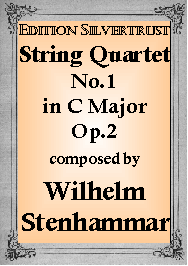Presents
Wilhelm Stenhammar
String Quartet No.1 in C Major, Op.2
 Some critics have
argued that Stenhammar's set of six string quartets is the most important
written between those of Brahms and Bartok. Whether this is so or not, there is
no denying that Stenhammar's quartets represent a very important development
during the twenty five years he was writing chamber music. Tonally, they range
from the middle late Romantics to mature Sibelius. Though not unknown by the
Swedish chamber music public, his string quartets have been sadly neglected
elsewhere.
Some critics have
argued that Stenhammar's set of six string quartets is the most important
written between those of Brahms and Bartok. Whether this is so or not, there is
no denying that Stenhammar's quartets represent a very important development
during the twenty five years he was writing chamber music. Tonally, they range
from the middle late Romantics to mature Sibelius. Though not unknown by the
Swedish chamber music public, his string quartets have been sadly neglected
elsewhere.
Stenhammar (1871-1927) was trained as a pianist, became a virtuoso and was considered the finest Swedish pianist of his time. Concert pianists who venture into the realm of the string quartet often wind up writing compositions which sound like they were composed at, and are perhaps better played at, the piano. This is certainly a valid criticism of some of the quartet writing of both Schumann and Mendelssohn. That Stenhammar's works show no such trait is due entirely to the fact that for nearly half of his life, he worked intimately with the Aulin Quartet, the top Swedish string quartet of its day and one of the best then performing in Europe. In fact, he toured throughout Europe with them for many years and a piano quintet was nearly always featured on their programs. Thus it is no accident that his quartets show a fine grasp of instrumental timbre and technique. The part writing is sure and evenly distributed with the instruments never being asked to perform in a non-violinistic manner.
String Quartet No.1 was composed in 1894. The opening theme to the first movement, Allegro, is dominated by its rhythm. The second subject, though also syncopated, is more lyrical. The poignant second movement, Mesto, is a dirge. Stenhammar instructs the performers to play it very simply, but with deep feeling. Though classical in its restraint, eschewing romantic emotionalism, nonetheless there is a Beethovian declamatory mood about it. An intermezzo, Molto tranquillo e commodo, follows. The playful melodies give the feel of an allegretto with an aura of calmness. The impassioned finale, Allegro energico, is said to have been based upon a Nordic folk tune, yet surprisingly, it sounds rather Spanish.
Long out of print, it is with pleasure that we make this quartet available once again. It should be of interest to chamber music quartet players everywhere.
Parts: $24.95